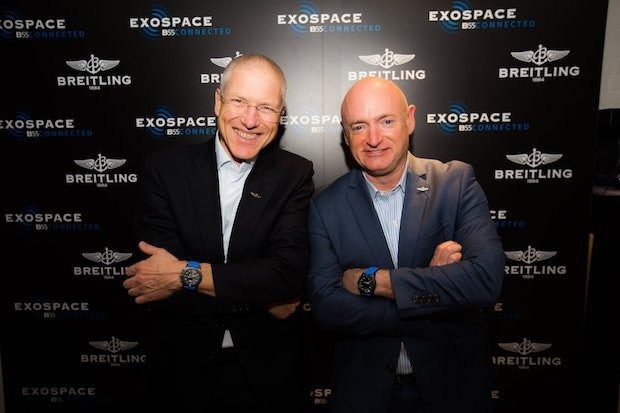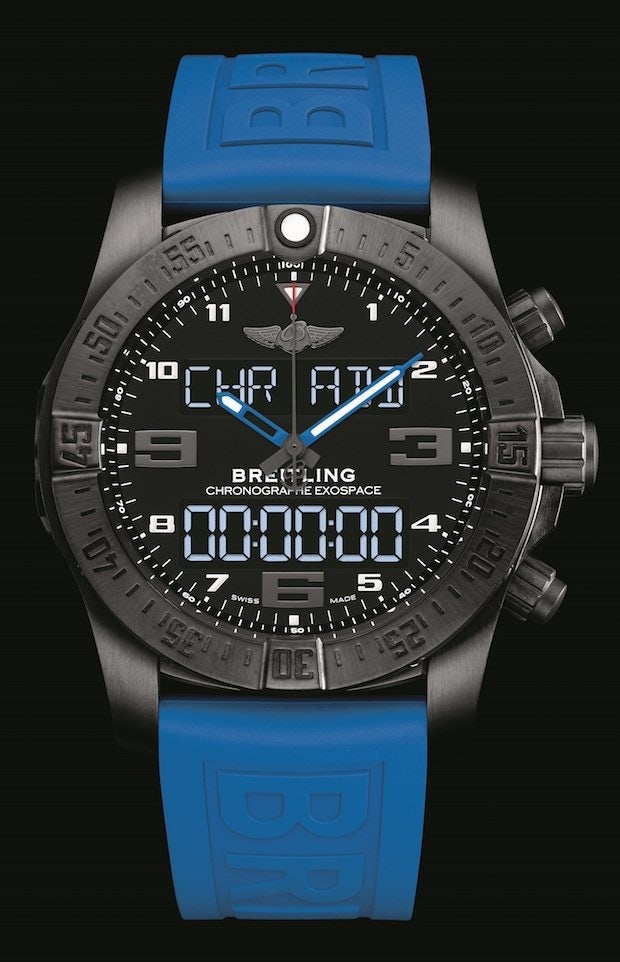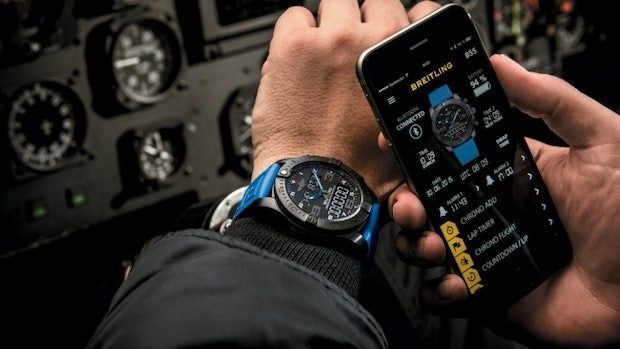
As several luxury watch brands slowly join the wearable tech revolution, Swiss watchmaker Breitling has become an early adopter with its new Expospace B55 model launched on December 16. Called a “connected chronograph” watch rather than a smartwatch, the new model joins the company’s line of aviation watches with enhanced functionality that places “the smartphone in the service of the watch,” instead of the other way around, according to the company.
While many traditional fashion-oriented classical Swiss watch brands have been searching for ways to integrate smartwatch-related technology in a way that fits with their brand heritage, Breitling’s positioning as a sport watch brand for pilots and divers makes it uniquely geared toward the introduction of new high-tech features to go with its Swiss heritage. In addition to a host of technical capabilities for pilots, the watch also has digital capabilities found in wearables geared toward the general public such as tracking for athletic activities.
As wearable tech and smartwatch technology become especially popular in the China market (China buys around one-fifth of the world’s Apple Watches), we interviewed Breitling Vice President Jean-Paul Girardin to learn more about the capabilities of the new device and the company’s future plans for China.
This new watch is described as a “connected chronograph” rather than a smartwatch. In what ways is it similar to a smartwatch, and in what ways is it different?#
For Breitling, it was a really pure logic to use this kind of new technology to improve the functionality of or our product. Because as you know, functionality beside precision and strong aesthetic is really an important keyword of Breitling’s instruments. The watch remains a real Breitling watch, with a real hand, real dial, water-resistant case, crown, two pushers, so it’s really a Breitling watch. It’s also a Swiss-made watch. But, where we added the connectivity to make the wearer’s life much easier when he has to use sometimes a complicated but a little bit difficult-to-use function. And using the user-friendliness of a smartphone, you can improve the functionality of the watch.
We didn’t try to have another terminal of a smartphone on your wrist because we cannot compete with a smartphone having a huge-display attached screen, but the watch has something very special. It’s very well-positioned on the wrist and always at hand, and using both devices for what they do best—meaning the user-friendliness of a smartphone and having the watch at hand all the time, you can have a great product using both instruments for what they do best.
This is why we just continued the Breitling way of developing new products using technical innovation like we did 100 years ago, when Breitling invented the pushpiece at 2:00 to facilitate the user’s chronograph or adding a slide-rule in 1952, or making flight destinations. At that time, it was already called a flight computer. Later, in 1995, we had the first Breitling Emergency. We were not talking about connected watches yet, but we were sending signals with that watch to satellites if you were in a distressed situation. With that watch, we found and saved more than 20 people. For us, using this kind of technology was really the way to innovate while remaining faithful to the Breitling history in terms of new products as well as the brand strategy.

Why was now the right time to move into connected watch technology?#
I think the quicker, the better. All this development was based on our first in-house quartz movement, which was presented 18 months ago at the Basel watch and jewelry show in March 2014. On that date, we understood we couldn’t do any more by adding another chip, by adding antennae, using the Bluetooth energy connectivity, which is really low-power. We developed everything in about 18 months. And that was really the right time to do that with our partners in Switzerland, to be able to come out on the market before the end of this year.
How do you think it will be received in China?#
We look forward, because this is something which is interesting for Breitling. Historically, the Chinese market is for Brieitling still a big potential for us. Historically, we have not been so present. First of all, we have not had the production capacity, and second, Chinese are learning very, very fast, which is good for us, but at the beginning, when they were interested in watches, that was more for classical watches: three hands, non-chronograph watches, and that’s not exactly the type or product we are specialists in. We are more specialists in big watches, chronograph, technical watches linked with the aviation, men’s watches. As I said, the Chinese are learning very, very fast and we look forward to seeing how this product may arise the interest in Brietling in the Chinese market.
The company focuses on diving and aviation watches, so is it tracking the development of these industries in China?#
Yes, of course. The more the aviation is developing in China, the better that will be for Breitling because if you talk about a pilot’s watch, you immediately think about Breitling.

This watch is intended for aviation, but people often wear the brand with a suit. Does the company aim to market the watch to general consumers in addition to pilots?#
First, what I would have to say is what is good for pilots is also good for a passenger or a non-pilot. The pilots’ requirements are quite tough in terms of precision, functionality, and legibility. So if it’s a good watch for pilots, it’s also a good watch for non-pilots. It’s easy to use, useful functions, and that’s why if you are developing a pilot’s watch, that will be a good watch in general.
Is this particular new watch model going to be geared toward the average consumer in addition to traditional pilots as well?#
Of course. We will have some specific functions which can be used as a pilot, but you can also choose this function and have other functions which are more focused on tracking and measuring sports activities—if you are running, if you are a sailor, if you are a golf player, this kind of of thing. It’s very, very user-friendly to go for a run, and then when you come back, you have your different laps or splits which can be downloaded from your phone and later on your computer if you want to keep track of your training. These kinds of features are also very useful for the general public.
Since private aviation has had a slow start in China, are Chinese clients mainly those that don’t fly?#
I think it’s a combination. A product has to be consistent. First, of course, every brand has its own image, but then the product has to be in line with the brand image, of course in terms of features, but also with aesthetic. I think the aesthetic of the watch is quite an important factor when you buy the watch. You are not going to buy a luxury watch you don’t like aesthetically. It’s a combination of all factors, in terms of brand image, aesthetic of the product, as well as the features and the quality of the product.
The watch has some capabilities similar to the Apple Watch. Would you consider this a competitor to the Apple Watch?#
No, you cannot compare the Apple Watch with the Breitling. The Breitling watch is a real Brietling watch in the first place, you can use it as a standalone device to have all the functions. You have to recharge it every one to two months. It’s really a different product. But, what we think is the new Apple Watch on the market now is very positive for the watch industry because we never talked so much about watches since a long time ago, and also, that is bringing interest, especially to the younger generation, to have something on the wrist. If you wear a watch, this is already good. It’s better to have somebody wearing any kind of watch than not wearing a watch. If Apple can bring the habit of having something on the wrist, that’s something that’s very good for the industry in general.
Breitling has one boutique in Shanghai. Are there plans for any more China expansion in the future? What are you seeing in terms of the Swiss watch slowdown in China and what do you plan for the future with that?#
We’re not suffering that much from the level-off or slowdown of the Swiss watch industry in China because we are still growing in China at a very low level. We see China still as a very huge potential for Breitling, which is good in terms of the next few years. Of course, we will adapt the presence of Breitling in China following our developments. For sure, Chinese customers are very important for Breitling because we see that is one of the remaining few big potential markets for the Breitling company.